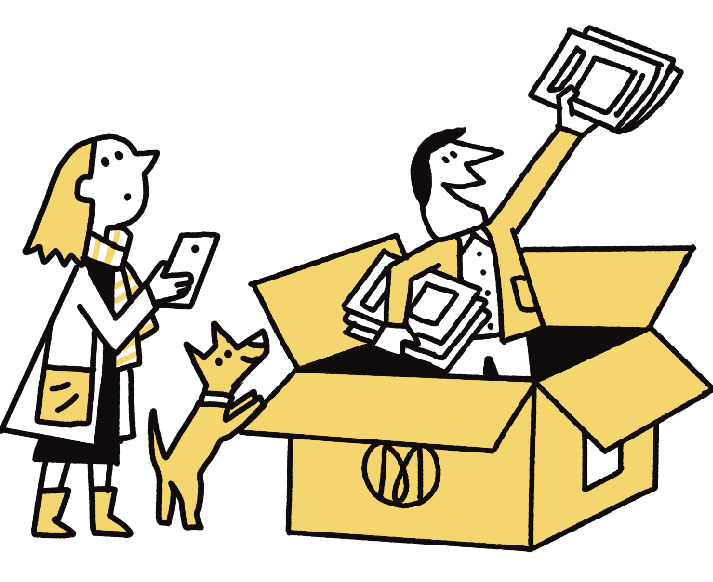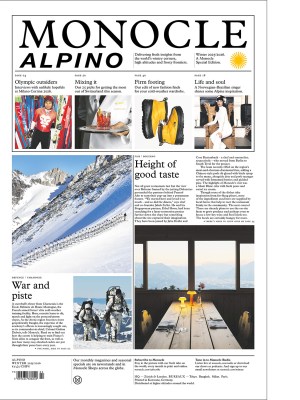“Most interesting cultural things emanate from restaurants,” Jeremy King told Monocle when he showed us around his newest project in London – the revitalisation of the beloved Simpson’s in the Strand. Yet today, hospitality isn’t geared around cooking up clever cultural concepts. Instead, the clattering of keyboards, zoom calls and menus downloaded anonymously via QR codes increasingly make us closed off to chance encounters.
But this hasn’t always been the case. In the 19th and 20th centuries, a ritual emerged in Europe’s metropolitan brasseries and coffee houses, where spirited intellectual artistic exchanges took place and fostered new ideas. Collectively known as literary cafés, these venues had three things in common: they offered a politically neutral space, were in central locations and served simple but reliable fare: a Comté omelette in Paris or goulash soup in Vienna.
In October this year Rome’s Antico Caffè Greco, which predates Italy’s unification, closed its doors. Its illustrious patrons included Charles Baudelaire, Federico Fellini and Sophia Loren. A month later, Café Gijón, Madrid’s last remaining literary café, was quietly sold to a chain. Founded in 1888, this bastion of old Spanish hospitality hosted tertulias – clandestine get-togethers where the likes of poet Federico García Lorca, playwright Antonio Buero Vallejo and novelist Francisco Umbral gathered to seek shelter from the Franco regime. More than just a pit stop for a reasonably priced café con leche, the space was a crucible of radical ideas that would shape artistic thought for decades to come.
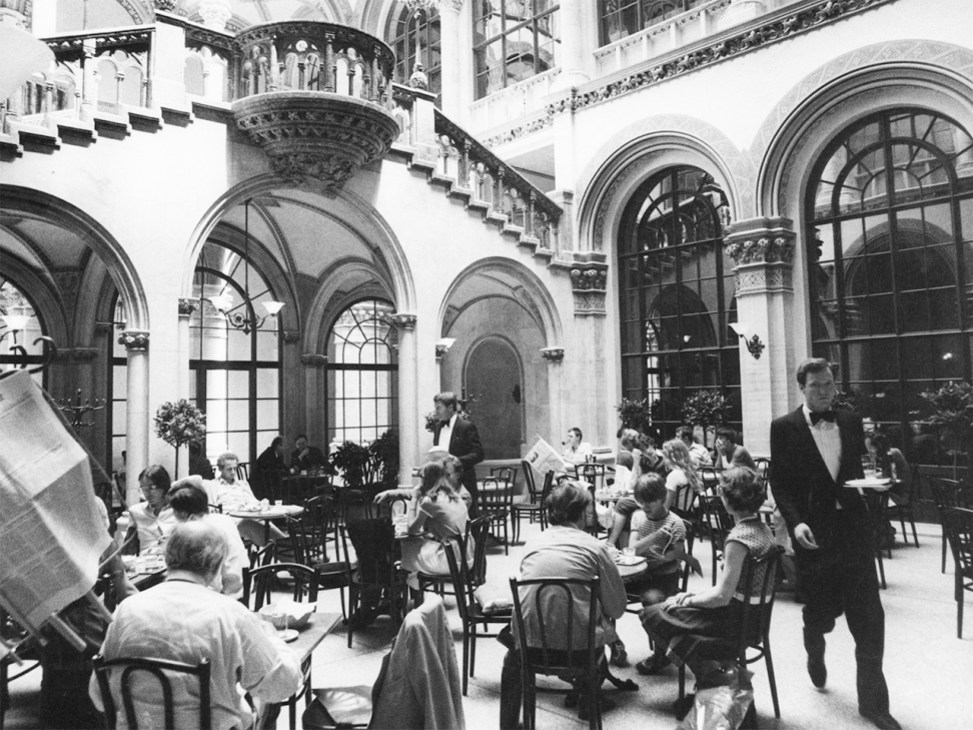
Today’s patrons need spaces like these in which to ruminate or meet new people. After all, there’s little inspiration to be found in a congealed burger delivered via Uber Eats. Yet many of the remaining institutions trade off their heritage, using it as cultural leverage to justify average coffee and kitschy desserts. Guests dine out on lacklustre pillars of nostalgia, while ghosts of the intellectual elite are mere status symbols. Takeaway culture and slapdash lunch breaks have also eaten away at the romantic, languid meals of hospitality’s golden era.
So how do we revive the literary café? A cluster of new-wave chef-restaurateurs has the right idea, with well-designed, multi-hyphenated hospitality spots that engage with neighbouring artistic programmes. Turkish chef Maksut Aşkar introduces Anatolian flavours within Rotterdam’s newest cultural venue, Fenix, a museum dedicated to migration in a city now home to 170 nationalities. In Tanzhaus, Zürich’s brutalist contemporary dance centre, Café Nude is a fitting hub for a cultural movement; patrons can glimpse the performers warming up on the upper levels. And in London, chef José Pizarro’s restaurant, Keeper’s House in the Royal Academy of Arts, boasts walls laden with canvases, inviting patrons to dine with fellow art lovers.
Some emblematic haunts remain. In Vienna in 1913, Austro-Hungarian foreign minister Count Leopold Berchtold predicted that Leon Trotsky, a regular at Café Central, would one day lead the Russian Revolution (or so the story goes). And in wartime Paris, Jean-Paul Sartre patronised Café de Flore, formulating the embryonic notion of existentialism. But these surviving literary cafés need to work harder to bring patrons together rather than luring in tourists over a parody of a bygone literary heyday.
Some of the most extraordinary ideas have been thought up over a croque-monsieur and a glass of sancerre. In Europe, solo dining now accounts for roughly one in six restaurant visits, so why not follow the crowd and book a table for one or chance a bar stool? Linger a while in a convivial café, bistro or pub – you might just find yourself in good company.
Claudia Jacob is a Monocle writer. For more opinion and analysis, subscribe to Monocle today.
Read next: How high-end tech misses the point in hospitality
1.
‘Magazine C’, South Korea
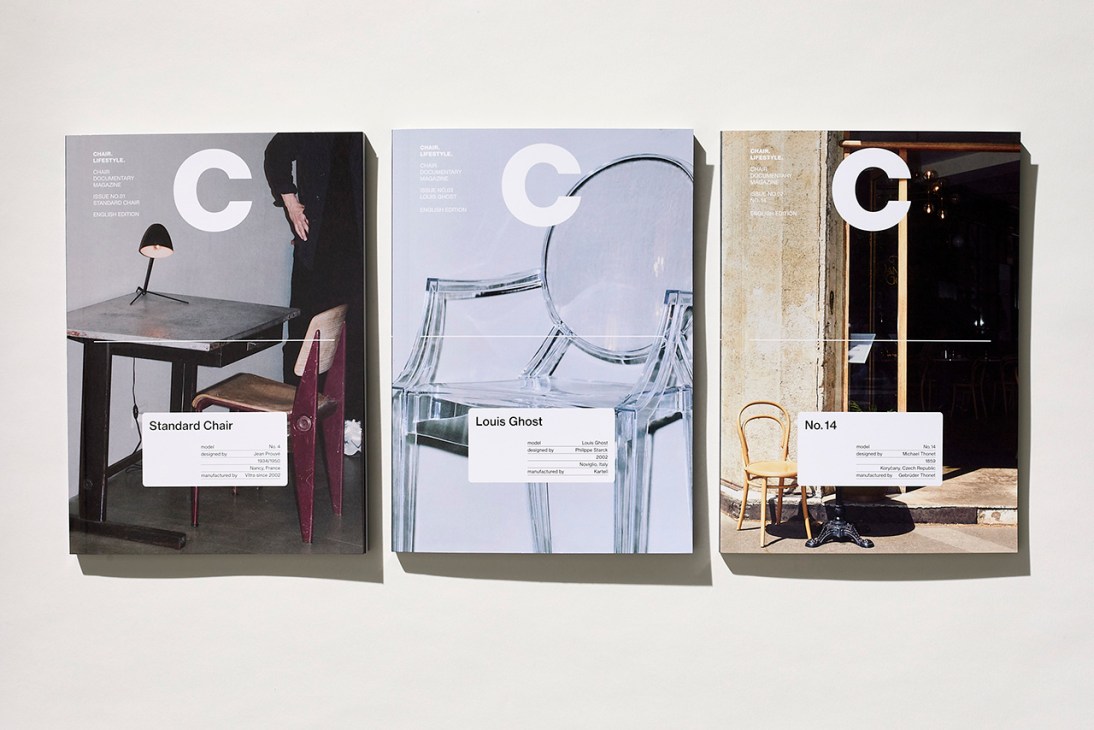
From the team behind Magazine B – the South Korean brand-documentary publication – Magazine C is a quarterly publication for furniture obsessives. Each edition is dedicated to a single chair, exploring the people, craft and stories behind a chosen design, starting with Jean Prouvé’s Standard chair, Thonet’s No. 14 and the Louis Ghost chair by Philippe Starck. Compact and sleek, the magazines have a considered aesthetic. A limited use of bright colours and crisp photography give the design a premium feel. Meanwhile, the familiar, neutral serif typeface of FK Roman Standard adds personality.

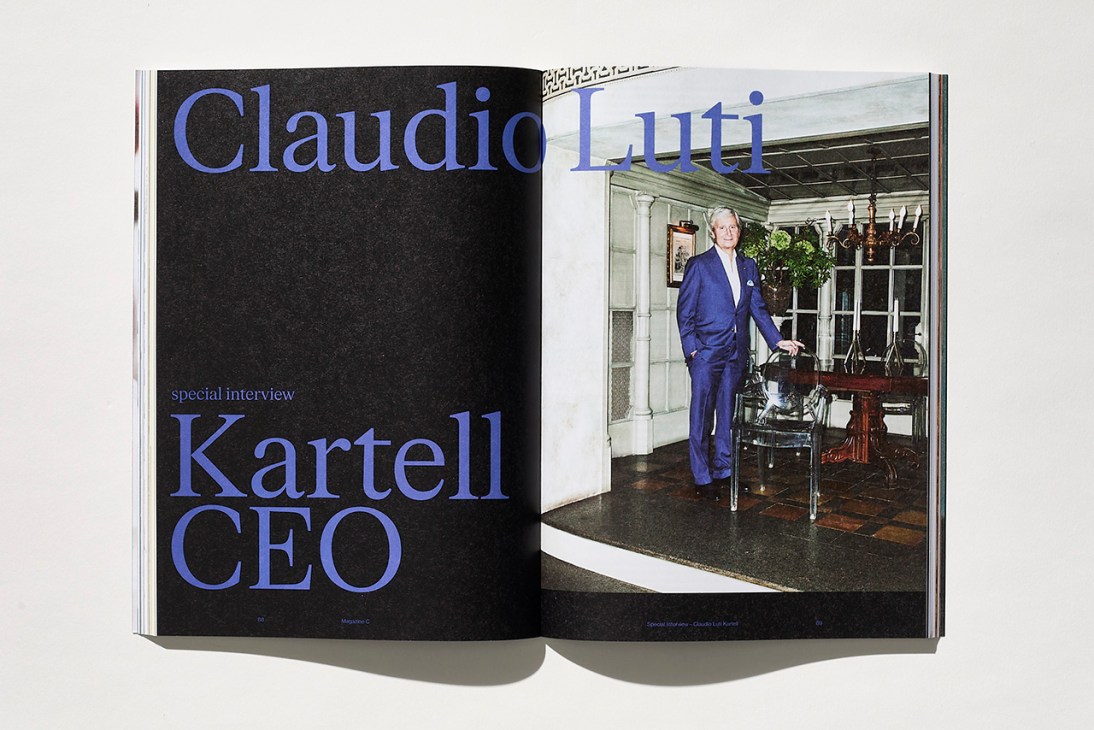
“Typography in general plays a central role in a magazine’s visual identity and editorial expression,” says editor in chief Minjung Kim. “It allows imagery of chairs and their surrounding contexts to be presented within a unified and coherent graphic framework.” A valuable contribution to design education, the magazine’s uniquely niche perspective offers a surprisingly diverse mix of content. From personal stories to lifestyle and architectural history, it successfully shows that there’s more to chairs than simply somewhere to sit – they can also be a lens on contemporary life.
reading-b.com
2.
‘The New Sustainable House’, Australia
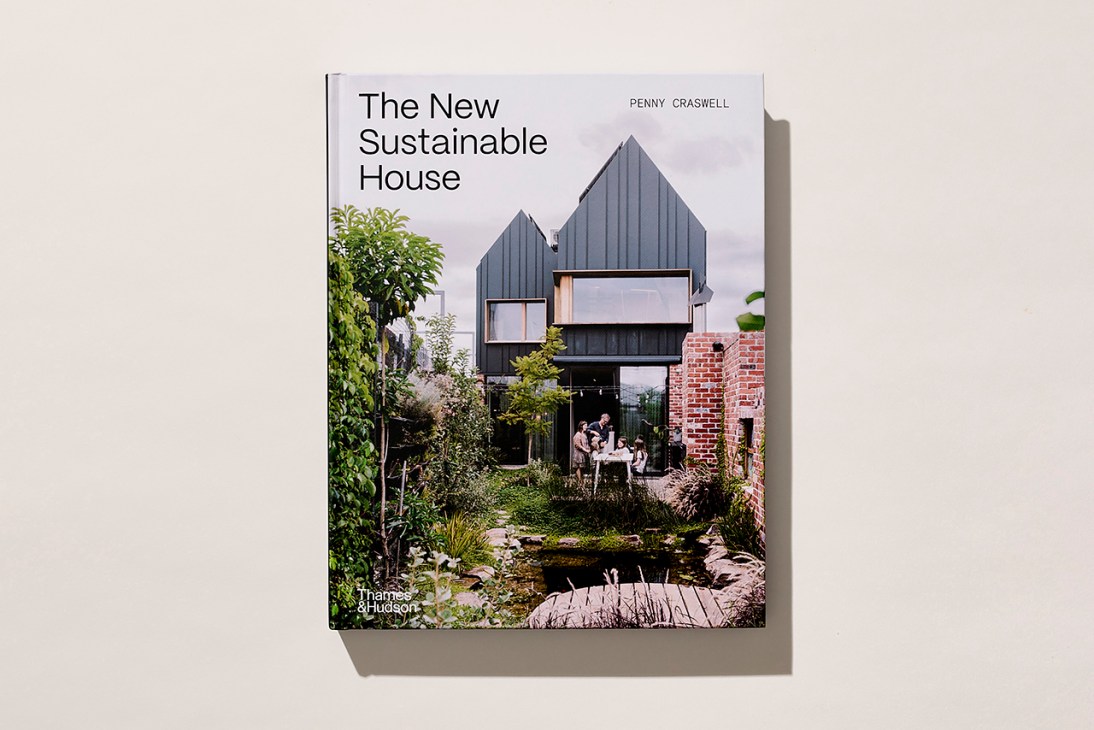
The New Sustainable House by Sydney-based writer and curator Penny Craswell is a rallying call to action. Architects, designers, builders and their clients have more information, technology and innovative materials at their fingertips than ever before; and yet the building industry is one of the world’s greatest polluters. The notion of designing with the environment in mind has been around for some time – but meaningful change has been slow.


To get the industry thinking even harder about its impact – and what is possible to achieve – Craswell profiled 25 architect-designed homes from around the world that stand out for their innovative solutions. Highlights include a single-storey mud-brick box built in the Texas desert and an all-timber Swedish cabin that is completely petrochemical-free. What unites this diverse lineup is the shared ambition of architects and clients to do as little harm to the environment as possible, without losing out on comfort or aesthetics. “There is no one quick fix to sustainable architecture,” says Craswell. But this book is as good a place to start as any.
thamesandhudsonusa.com
3.
‘A Passion for Jean Prouvé’, France

A Passion for Jean Prouvé: From Furniture to Architecture showcases works by the 20th-century French engineer, architect and metal artisan from the collection of gallerists Laurence and Patrick Seguin. Generously illustrated with photographs and previously unpublished drawings, the bilingual publication demonstrates how Prouvé was a strong advocate for mass production and industrial techniques.

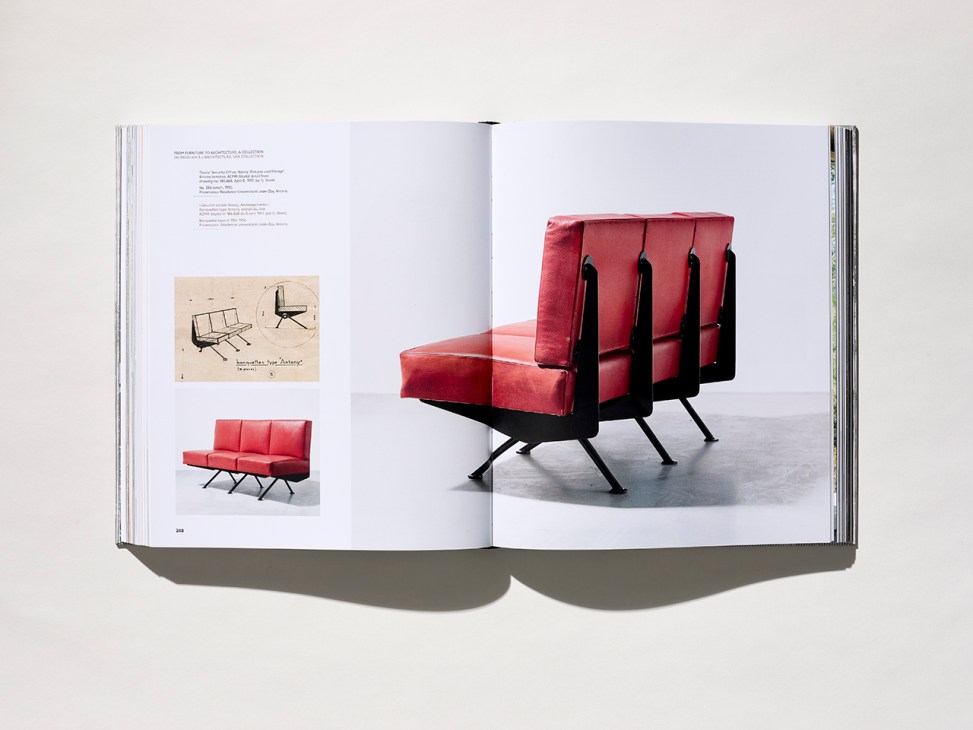
The Seguins’ private collection features little-known pieces, such as the 1939 Saint-Brévin table, as well as more iconic works, including the Métropole chair and the 1930 Cité armchair. The collection is split between their Paris apartment and gallery and their estate in the south of France, where Prouvé’s demountable houses are installed en plein air. The Seguins’ passion for Prouvé’s work attests to his creations’ enduring charm. “His modernity prefigured many contemporary approaches,” say the collectors. “There is a real dialogue – a synergy – between his furniture and contemporary art.”
patrickseguin.com
4.
‘Casa Mexicana’, Mexico

The rich architectural tradition of Mexico, defined by sun-soaked concrete walls and wooden ceilings, is the subject of Casa Mexicana – a new publication from British publishing house Thames & Hudson. With photography by Edmund Sumner and text by London-based architecture journalist Jonathan Bell, this colourful monograph takes its readers to 26 homes across the country. From tucked-away houses on the streets of Mexico City to beachside retreats in Puerto Escondido, the book is an exploration of contemporary brutalism and natural textures such as concrete, stone and wood, which seamlessly blend into dense greenery and dramatic landscapes.


Sumner’s photographs capture sweeping vistas and intimate details, while floor plans and drawings offer technical insight. Architects such as Ludwig Godefroy and Mauricio Rocha appear throughout, showcasing the range and ethos of Mexican design today. Whether you’re dreaming of a remote getaway or want to explore the structural nuances of a dynamic architectural movement, Casa Mexicana is a visual journey into the heart of the nation’s built environment.
thamesandhudson.com
5.
‘Dakar, Métamorphoses d’une Capitale’, Senegal
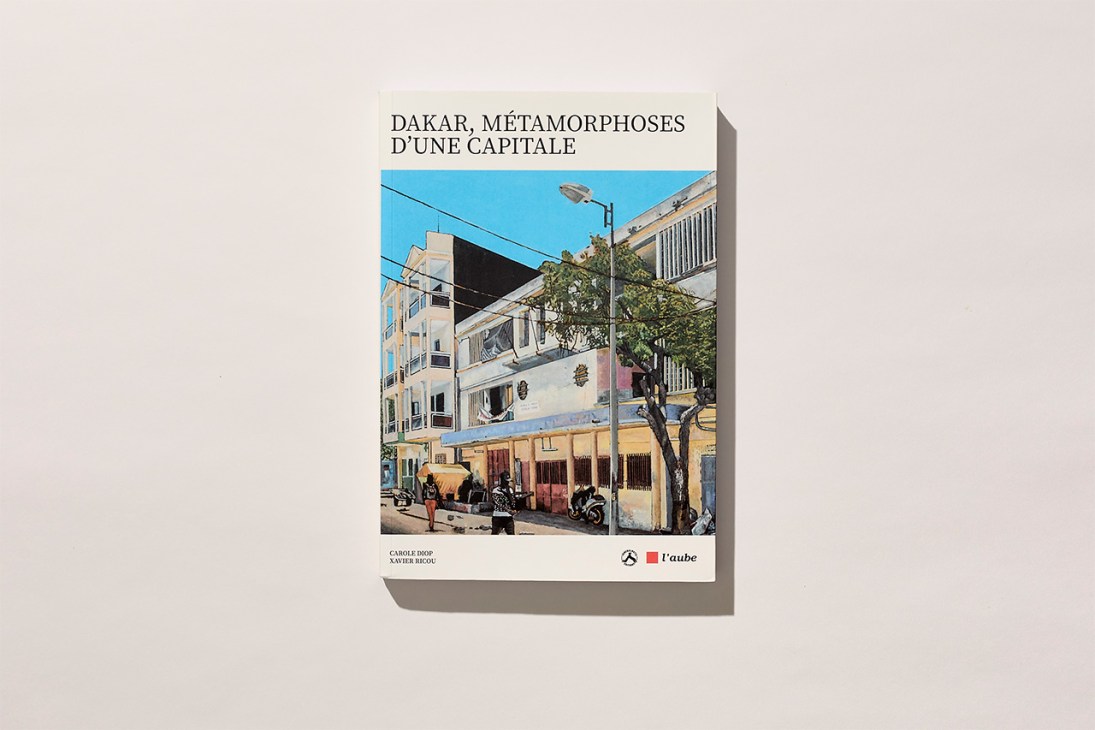
All cities must change if they want to avoid becoming static mausoleums – but what’s at risk when that transformation happens too quickly or almost indiscriminately? Authors Carole Diop and Xavier Ricou are worried that part of their hometown, Dakar, is losing its architectural soul in the process of relentless modernisation. So they have put together a book called Dakar, Métamorphoses d’une Capitale. It’s half a portrait of the city, half a manifesto for sensitive preservation and wholly a case study for urban planning across Africa.
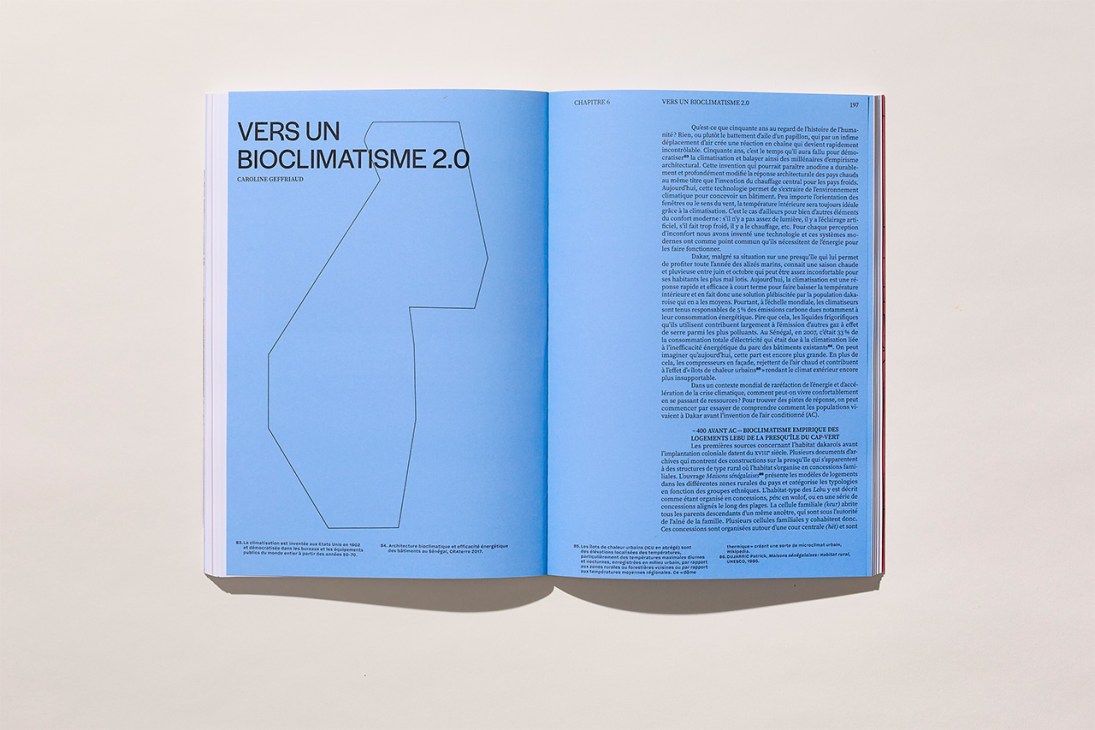

From its beginnings as a series of fishing villages inhabited by the Lebu people through to its official founding as a city in 1857, the colonial era and post-independence expansion, each of the Senegalese capital’s historical chapters is explored with illuminating photography and cartographic evidence that unearths traces of the past in the present. Published by Éditions de l’Aube, it’s an ambitious, impassioned and necessary work. It’s also a rare opportunity to admire pictures of Dakar’s modernist, neo-Sudanese and art deco treasures, as well as the masterpieces of asymmetrical parallelism that shaped its visual identity. All 450 buildings are neatly laid out in the book’s closing inventory, an impressive catalogue of a heritage under threat.
editionsdelaube.fr
Vladimir Kara-Murza is a Russian opposition politician and Pulitzer Prize-winning columnist for The Washington Post. In April 2023, he was sentenced to 25 years in a Siberian prison colony after being convicted by a Russian court of charges related to his criticism of Russia’s invasion of Ukraine. He was released in August 2024 as part of a prisoner exchange.
Kara-Murza spoke to Monocle Radio’s Andrew Mueller about how he survived solitary confinement and facing what he believed to be his impending execution before an unexpected release.
This interview has been edited for length and clarity. Listen to the full version on The Big Interview from Monocle Radio.

Can you articulate the feeling of standing in the dock and being told that you’ll do 25 years?
My first thought was: ‘Job well done.’ Because in the distorted, Orwellian reality of Vladimir Putin’s Russia, that is the highest mark of recognition that you can earn for political opposition work. I’m also a historian, so I couldn’t help but think of the fact that this was the longest sentence handed down to a political prisoner in our country since the death of Josef Stalin in 1953.
How did you adjust to the idea that this was your life now?
There’s a saying that the subconscious dream of every historian is to experience the subject of their studies in person. But be careful what you wish for, because one of my areas of study is the dissident movement in the Soviet Union. It was astonishing how much the gulag system, down to the smallest details, has remained the same as what you read about in writings such as Vladimir Bukovsky’s book [To Build a Castle: My Life as a Dissenter], which was published nearly half a century ago.
What were your days like when they were reduced to being inside a small cell?
I spent close to a year in solitary confinement with no breaks. You sit in a tiny, three-by-four-metre cell with a small metal-barred window under the ceiling. Your bunk is attached to the wall at 05.00 with a wake-up call, and taken down again at lights out at 21.00. The guards bring you a pen and paper each day, and you’re allowed to write for an hour and a half. Then they take the paper and pen away, and there’s nothing for the rest of the day. All you can do is aimlessly walk in a circle, wallowing in your thoughts and memories.
When did you understand that you were being released?
It was the middle of the night. I was suddenly woken up by the loud screeching of the cell doors being burst open. A security officer barged in with a few guards and told me, ‘Convict Kara-Murza, you have 10 minutes to get up, get dressed and get ready.’ At that moment, I was certain that they were going to lead me out to the forest and shoot me. But instead, they drove me to the airport.
Why did you go back to Russia? You knew the risks – you’ve been poisoned twice and many of your friends and colleagues have been imprisoned and/or killed.
Russia is my country, my home. I love Russia. It’s a beautiful nation with a lot of talented people. It just happens to be ruled by a criminal, murderous, kleptocratic, KGB-led dictatorship. I want my country to be better than it is today. And unless we do something to bring about change, it won’t happen. I’ve always believed that the only way politicians can truly lead is by personal example. What right would I have to tell my fellow citizens to stand up to the Putin dictatorship if I were too scared to do it myself?
Listen to the full conversation with Vladimir Kara-Murza on Monocle Radio.
It is difficult to overstate the shock that will have been felt among Sydneysiders at Bondi Beach yesterday. Australians have been victims of terrorism before – there were 88 among the 202 people killed in the 2002 Bali bombings – but the country itself has almost no history or tradition of deadly sectarian violence. Recent vaguely comparable incidents – the 2014 siege at a Lindt Café in Sydney, which left three people dead, including the perpetrator; and the 2015 murder of a police accountant in Sydney’s western suburbs, after which the killer was shot dead by the victim’s colleagues – were understood more as the actions of the mentally ill rather than due to religion or politics, whatever vainglorious pledges of fealty to Islamic State were made by the lone gunmen responsible.
The two shooters at Bondi were father and son, indicating a plan involving at least that many conspirators. Of their motives, we might glean all we wish to know from their choice of target: an event celebrating the commencement of Hanukkah. At time of writing, 15 of the people who went to this day at the beach are dead (not including one of the gunmen) and at least 29 injured, some critically.
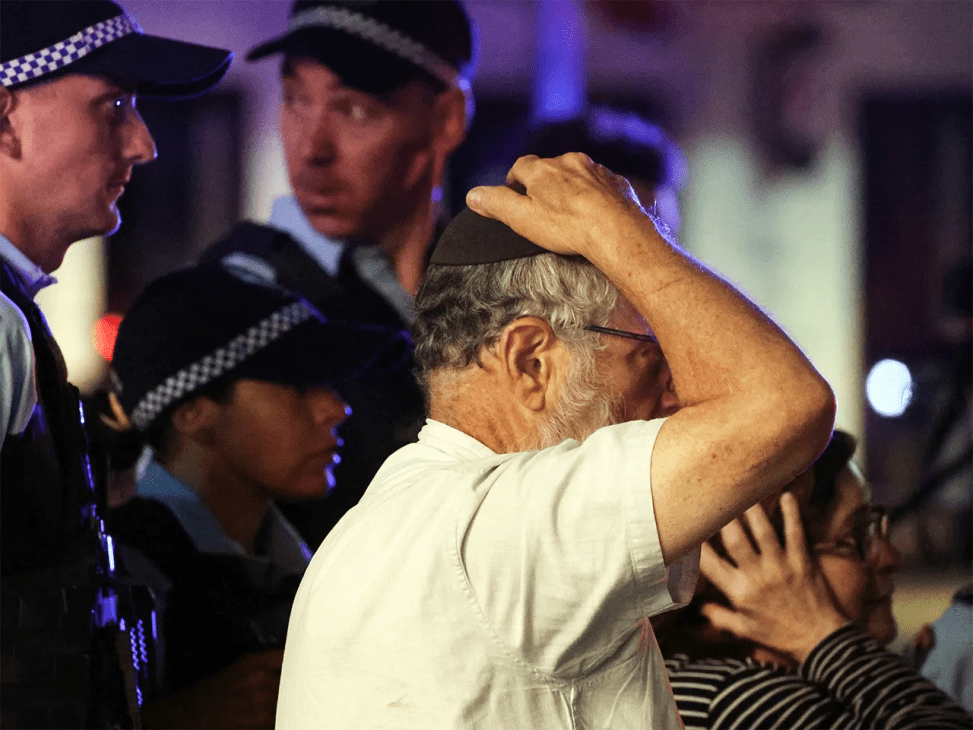
Australia’s prime minister, Anthony Albanese, is now besieged by a cacophony of questions, none of which have easy or agreeable answers. Leaders of Australia’s Jewish community have long warned of the hazards of over-indulging extremist elements among the regular protests against Israel’s conduct in Gaza. There has been a steady tick of anti-Semitic vandalism, arson and threats of worse, some of which the intelligence services linked to Iran: the Islamic Republic’s ambassador was sent home from Canberra in August. Nevertheless, Israel’s government has piled in noisily and unhelpfully. Prime Minister Benjamin Netanyahu suggested that Australia’s recognition of a Palestinian state in September had somehow encouraged Sunday’s atrocity – a statement which, ironically, echoes the inane “root causes” refrain much beloved of leftists who seek to excuse terrorists responsibility for their choices.
Australia’s noisy cohort of anti-immigration xenophobes will also be insisting that the Bondi massacre vindicates their paranoia. There is considerable potential for further ugliness.
But there are things that Albanese could say, and/or do. Australia recently introduced a ban on most social media for under-16s, and placed the onus on social-media platforms to enforce it. That could be elaborated upon, in that social-media platforms should be held accountable, on pain of having their plugs pulled, for everything that they permit to be published (online hate is not some natural and inextinguishable phenomenon; it simmers and roils because the platform proprietors choose to do nothing about it). He might also note that now would be a good time for Australia’s increasingly vociferous gun lobby to give it a rest. The Bondi shooters were restricted to hunting rifles and shotguns as a consequence of the country’s correctly robust response to the 1996 Port Arthur massacre. Rules on the ownership of automatic and semi-automatic weapons were drastically tightened, and more than 643,000 firearms taken out of circulation in a buyback scheme.
Much will be written, as it should be, about the hero of this miserable hour: Ahmed al Ahmed, a 43-year-old fruitseller who disarmed one of the Bondi gunmen and was wounded by the other. He is undergoing treatment for his injuries while a nation – and the world – marvels at the footage of his courageous actions. He could easily have taken cover and nobody would have blamed him. Instead, he launched himself at an armed and murderous maniac, who might also have been strapped with explosives or concealing other weapons. Ahmed would have understood that this could have been the last thing he ever did. He did it anyway and there are certainly people alive today who would otherwise have been counted among the victims of Sunday’s horror.
All of us – individuals and societies – prefer to think of ourselves as noble. None of us – individuals or societies – really have the least idea how we will react to a given circumstance until or unless we are in it. Wittingly or otherwise, a middle-aged shopkeeper from Sydney has demonstrated the attitude that Australia – and, one might hope, all nations – should take to the eternal lunacy of anti-Semitism: Nope. No you don’t. Not here.
Andrew Mueller is the host of ‘The Foreign Desk’ on Monocle Radio and a regular Monocle contributor. For the latest news and reaction to the Bondi Beach attack, tune in to ‘The Globalist’.
For the past 25 years or so, Christmas has usually been an Alpine affair. There have been dashes down to Palm Beach north of Sydney, one Christmas in Toronto and a few years back we tried Zürich but it wasn’t the same as being up at our cosy flat in St Moritz with the ancient Denon stereo still spinning well-worn Christmas CDs (Helene Fischer, Idina Menzel, Tatsuro Yamashita, Dean Martin, Ella Fitzgerald and Nancy Wilson), the same decorations on the tree, the amazing smells coming from the kitchen (cardamom, yuzu and dill) and the sounds of the village coming alive for the season.
This year, for the briefest moment, we thought about doing Christmas in Lisbon and got quite excited about filling the shopping trolley at El Corte Inglés and lunch on the sunny terrace. But then we realised that there would be new decorations to be purchased, revised lighting requirements (it is very different to find just the right level of gold light, which is why my mom tends to paint every bulb to take the edge off) and a race to ensure that Lisbon has all the right Swedish and Estonian ingredients. No such worries up in St Moritz as we know every supplier and retailer, and dinner on the 24th comes together seamlessly thanks to our solid set of purveyors.
Having an advance party in place is also useful and for the coming season our Zürich colleague Aude is running the show in our St Moritz pop-up shop and mini café at the Hotel Steffani. By far our smallest retail outpost, it has already been doing a roaring trade and if you happen to be up around the Engadine this winter be sure to drop by for a mocha and any presents that you might need over the coming weeks. As ever, we’ll be hosting a little Christmas cocktail sometime between 25 and 31 December. So keep an eye out for the invite – likely to be sent some time next week.
Before pouring gin and tonics (the evening ritual from the 22nd, this is where the fresh yuzu comes in) and breaking open the rice crackers from Mitsukoshi, there’s still a bit of ground to cover. I was hoping to be in London yesterday and today for the Christmas Market but there’s a rather exciting project under way in Zürich that requires many hands on deck to pull it together and get it humming for the year ahead. You might recall that we have a Monocle apartment at the Oxen in Küsnacht – just down the lake from our offices in Seefeld. From next week the Monocle Townhouse will be nearing the finishing line as furniture arrives from various corners of Europe and ‘real’ lightbulbs are screwed into position for just the right tone and glow. An elegant annex of the Widder Hotel in the heart of Zürich, the Monocle Townhouse will be available for short or long stays and is perfectly positioned for quick connections from the main station and an easy tram hop to our café, shop and Trunk Clothiers outlet on Dufourstrasse. Official photography will take place in the new year, so expect a proper first peek early in January. Also, Monocle Patrons can expect a special invite to a debut cocktail at the start of spring.
If you’re passing through Zürich, pop by to say hello, grab a negroni and enjoy the Christmas mood. Ditto in London and Paris as they do negronis as well! Much of the Monocle advertising crew will be in Zürich this week as we plot out 2026, so it will be a full house and we’re on hand if you want to discuss big ideas for your brand or business. The bar is always open from 16.00. Wishing you a good week ahead. We’re in the home stretch!
Enjoying life in ‘The Faster Lane’? Click here to browse all of Tyler’s past columns.
Eating in Parma means enjoying a trio of heavyweights: Parmigiano Reggiano, Prosciutto di Parma and Culatello di Zibello. These Protected Designation of Origin (PDO) products need little introduction and reward deep exploration. Once you understand that every facet of Parma – its markets and cafés, osterie and trattoria – revolves around the making and eating of these three staples, you’ll start to see the city in its truest light.
From there, the city’s food culture becomes as much about lessons in produce as it does about cooking and tasting. Language and ingredients are intensely local.
Nowhere is that regional loyalty clearer than in a scene witnessed in a cramped bar on Viale Giovanni Mariotti, where a debate unfurled over the specificities of fried dough. Monocle sat back to watch two sharp-suited gentlemen, one from Modena and one from Parma, argue intensely over whether the golden pillows on their plates were gnocco fritto or torta fritta.
Fighting over the etymology of a provincial speciality might seem eccentric. But in Parma, such distinctions matter – as you’ll find out during your discovery of the city.
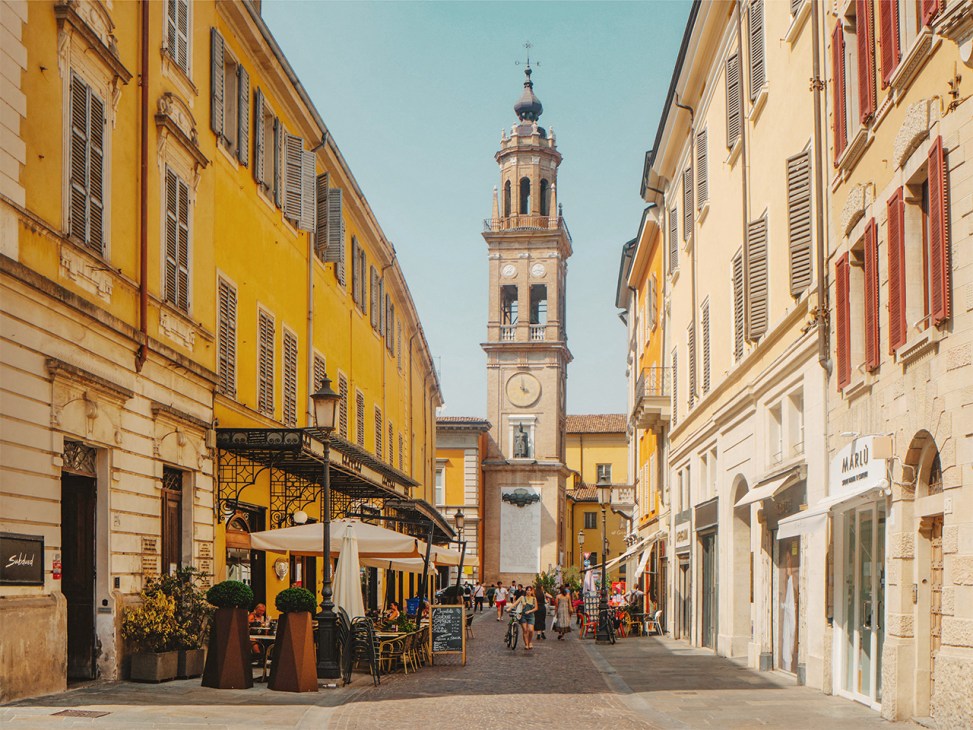
Where to eat in Parma if you’re visiting for the day
If you only have a day to spare, give it to the cheese that built the city. Start at one of Emilia-Romagna’s 300 dairies, get lost in the old town for an hour or two and finish at a vintage trattoria, if only to taste what wonderful things can be done with Parmigiano Reggiano.
Caseificio Bertinelli has stood on the same site in Noceto since 1895 and is now run by Nicola Bertinelli, a sixth-generation farmer who knows this cheese inside and out. What looks like mass production, he says, is an ancient process born from four ingredients: milk, salt, rennet and time. In the dairy room, the air is thick with copper steam as the casaro coaxes twin curds from a bell-shaped vat and hoists them into their moulds. Next door, the warehouse is filled floor to ceiling with rows of maturing wheels while an affineur makes his rounds, tapping each wheel with a small hammer to test whether it’s ready for the PDO firebrand.
For the ham enthusiasts, here’s where to find the best prosciutto in Parma:
· Podere Cadassa, Colorno: Ancient curing cellar with 7,000 Culatelli. Grab a bite next door at Al Vèdel.
· Antica Corte Pallavicina: Hotel and restaurant offering cooking classes and tours of its historic cellars.
· Museo del Prosciutto di Parma: Quirky museum with year-round events and tastings.
Back in town there are two essential afternoon stops: Salumeria Garibaldi and La Prosciutteria. Both are stocked with PDO products of every imaginable age and variety, and can count themselves among the most fascinating food shops you will ever set foot in. It will be no surprise if you find yourself leaving with a wedge of 24-month Parmigiano for cooking, a packet of 48-month shards for aperitivo and a vacuum-packed Culatello for whoever waters your plants.
By night the discipline that dictates Parma’s dairies softens into pleasure at an old guard of restaurants that have stood for generations. Trattoria del Tribunale is convivial and gloriously kitsch, the sort of place where the menu hasn’t changed because it never needed to. Ristorante Cocchi, meanwhile, is the 100-year-old elder statesman of the city: think linen-clad tables and waiters who know the wine list by heart. The benchmark, though, is Ai Due Platani. Tricky to get a table, it regularly tops any serious list of the best trattorie in Italy and holds a Bib Gourmand for good measure.
And with so many well-heeled couples lingering over bottles of lambrusco, you soon see why. The waiter recommends a selection that showcases different ways Parmigiano Reggiano can be used. Great hunks of 48-month-ageed cheese to enjoy as an aperitivo (salt crystals crunching as you bite), then 24-month with hot torta fritta (or gnocco fritto, depending on who you ask). And don’t leave without trying the tortelli. Half the plate is di erbetta, silken and green with ricotta and chard, and the other is zucca, tawny and sweet pumpkin with marsala wine. Both demand a generous snowfall of 12-month Parmigiano Reggiano to make the dish whole. If you only have a single evening in Parma, this is where to spend it.
Two dairies to visit in Parma:
· Caseificio Bertinelli, Noceto: Established in 1895 and run by the current president of the Parmigiano Reggiano Consortium, Nicola Bertinelli.
· Caseificio Gennari, Collechio: Family-run dairy with one of the most extensive ageing programmes in Italy.

A gastronomic adventure for longer stays in Parma
If you have more than a day, you have enough time to venture out into the lowlands and visit the curing cellars beginning with Podere Cadassa in Colorno for a masterclass in Emilia-Romagna’s other great obsession. As the iron door swings open, the space nearly knocks you sideways with its scent. “The secret?” asks Enrico Bergonzi, whose family have been curing Prosciutto di Parma and Culatello di Zibello here since 1780. “Good mould!” he says. Ducking between hanging rows of Culatelli – each tied and re-tied throughout the seasons – you feel and smell how produce can hold centuries of family history.
Thankfully you needn’t go far to taste that history either as the Bergonzi family’s cellar adjoins Al Vèdel, one of the region’s most beloved dining rooms. A word of warning: Sunday lunch in Italy is part meal, part opera with families descending on the restaurant in their multi-generational dozens. The volume level rises slowly throughout the afternoon and on more than one occasion, the waitstaff will need to steer the dessert trolley clear of an overly animated hand gesture. The kitchen is just as charming, making fine use of its prized Culatello in dishes such as tortel dols, a bittersweet ravioli, and a selection of rare cuts served with butter from Urzano.
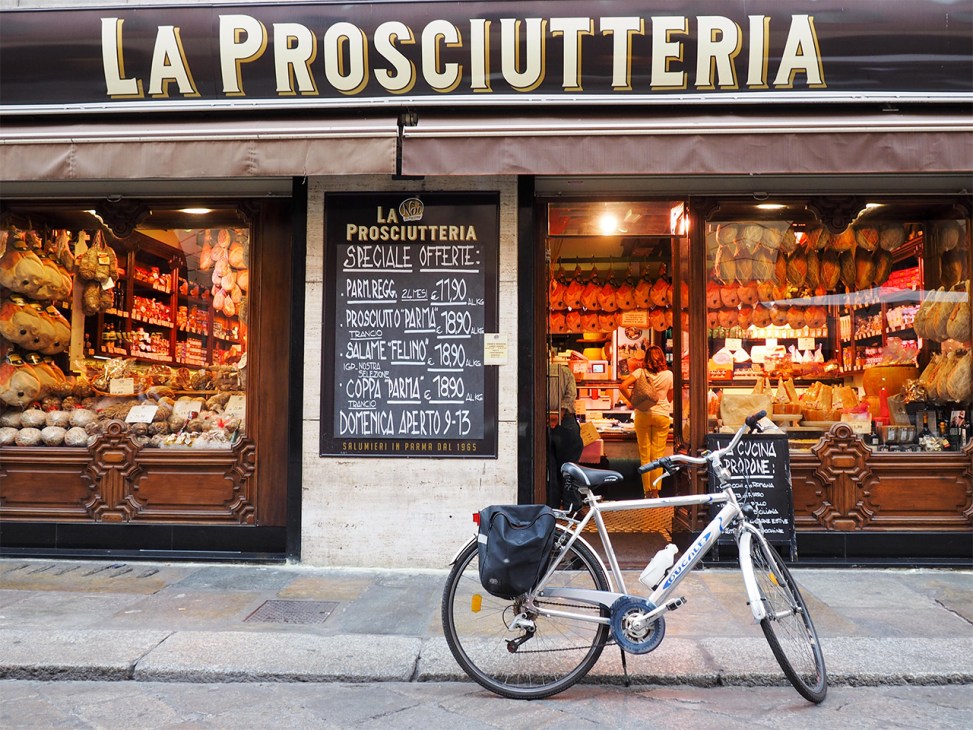
Back in Parma you have the chance to see how the city’s chefs are reimagining its best-known exports. Just behind the yellow façade of Piazza Garibaldi is the pared-back Croce di Malta – welcoming and minimalist with pale walls, soft light and an understated crowd. A highlight is the deconstructed aubergine parmigiana with seared slices resting on a foamy cloud of Parmigiano-Reggiano béchamel. Across town, Cortex Bistrot pushes things even further with ambitious tasting menus that nod to tradition without being bound by it.
Then there’s Parma Rotta: the 40-year-old grande dame of the city. A meal here begins with the classics (tortellini in brodo is a non-negotiable) before a surprise from chef Antonio di Vita, who wheels out a trolley of fior di latte soft serve with an array of retro sauces. Chocolate and strawberry are tempting but he insists on his housemade zabaglione, a warm custard of egg yolks, sugar and marsala wine poured over ice cream. The two components meet, melt and make a strong case for one of life’s great unions.
Parma gets on with things whether you are paying attention or not. Dairies churn at dawn, cellars slice before lunch and dinner lands on linen that never stays white for long. But spend even a short time in this city and what stays with you is the sense that produce and place have never been separate. They are simply the same story, told in a million mouthfuls.
When to visit Parma
Caseifici Aperti, the city’s open-dairy festival, takes place twice a year (spring and autumn). But most dairies offer tours and tastings year-round.
What to order in a panic
Torta fritta with Culatello. Anolini in brodo. Tortelli di erbetta or pumpkin. A wedge of 24-month Parmigiano Reggiano for the table. A glass of good lambrusco.
How to sound like a local
Call it torta fritta in Parma and gnocco fritto in Modena. Smile either way.
Europe should have seen it coming but the US government’s new National Security Strategy (NSS) nevertheless sent a chilling wind across the Atlantic. The messaging has been there since Trump took office in January: his vice-president, JD Vance, set the tone at the Munich Security Conference in February when he declared that Europe was on the brink of destroying democracy and might not deserve future US assistance.
It has been put down on paper in a 33-page document alleging that the vieux continent is facing “civilizational erasure” because of migration, while being governed by “unstable minority governments” who “trample on basic principles of democracy to suppress opposition”. Reading more like a blueprint for covert action against a despotic regime than a pragmatic assessment of relations with the US’s oldest allies, the strategy suggests “cultivating resistance to Europe’s current trajectory within European nations”.
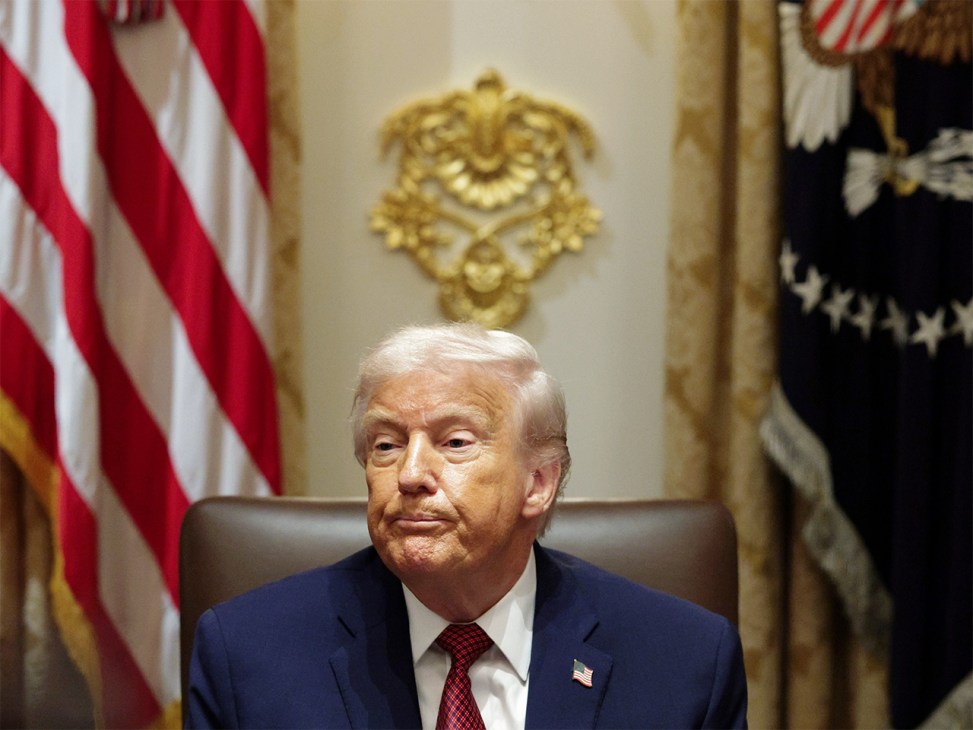
Which resistance to cultivate is also spelled out: “The growing influence of patriotic European parties indeed gives cause for great optimism,” the document reads, clearly referring to rising far-right, anti-immigration forces in Europe. While this document could be dismissed as more Trump bluster as he seeks to get his own way on the international stage, particularly on Ukraine, the formalisation of such a fundamental shift in US priorities should be a huge cause for concern in European capitals.
The NSS is an outline of the foreign-policy doctrine and national security interests of the US, periodically published by the White House to reflect any significant shift in policy. It is meant to inform relevant agencies and embassies about how they should target both their diplomatic efforts and their funding. Trump’s foreign-policy approach is a long way from Joe Biden’s democracy-first agenda, in which Europe was seen as an essential partner in promoting security around the world.
The president campaigned on an “America First” platform, vowing to protect national interests above all else, which is reiterated in the strategy’s preamble: “The affairs of other countries are our concern only if their activities directly threaten our interests.” What will disturb many in Europe is how closely US interests appear to align with those in the Kremlin. The country is only mentioned in the general context of Europe, stating that the US goal is to “re-establish strategic stability with Russia”. Kremlin spokesperson Dmitry Peskov smugly confirmed that the strategy was “largely consistent with our [Russia’s] vision”.
Beijing also gets off lightly, with most of the focus on China’s potential as an economic competitor rather than a strategic geopolitical threat. Middle Eastern nations are off the hook for any human-rights violations, with the strategy dismissing the “misguided experiment with hectoring these nations – especially the Gulf monarchies – into abandoning their traditions and historic forms of government”.
The US also shows much more interest in its backyard, declaring that relations with Latin America will be reset, along with a warning that “the use of lethal force” would be deployed if needed to stop narcotics smuggling. Any illusions that the strategy is mere words are disproved by Trump’s recent actions. In essence, the document distils everything that Trump has done on foreign policy since his re-election.
He has given an easy hand to Russia and China and cosied up to authoritarian regimes in the Gulf, while frequently chastising Europe and bombing alleged drug-trafficking boats in the Caribbean. That the strategy and its hammering of the transatlantic alliance came out just as Trump tries to sell his Ukraine peace plan to a reluctant Europe is no coincidence.
It sends the message that the US has no interest in alliances unless its partners embrace the whole Trump-Maga doctrine. Any misconceptions in Europe that another fawning Oval Office visit will shift the dial on Ukraine or any other matter should be shattered for good.
Charlotte McDonald-Gibson is a Washington-based journalist and regular Monocle contributor.
There has been a lot of shuttling back and forth to Paris since February when we opened our bureau in the city. On many of my stays, I have lodged at the small four-star Hôtel Pulitzer, a short walk from our office. They make a good omelette. I like the rooms. They have me, however, because the staff are nice. At breakfast on Tuesday, it was the same gentleman in charge as usual. He smiled and said, “Hello Mr Tuck, you’re back!” But my favourite part has become the welcome notes that they leave in my room. In the beginning these were a simple “I hope you enjoy your stay” style of greeting but this week there was a note thanking me for my loyalty across the year and explaining why this commitment matters to a hotel. “Guests like you are a gem” it stated (or perhaps I misread the handwriting and it actually said “guests like you are a germ”? I hope not). And someone has noticed where I work – and perhaps even read this column – because another recent note sent best wishes to Macy, the fox terrier. They even congratulated me when I won an award (no, it wasn’t for flower arranging or the nicest plums at the county fair). This week I decided to turn the tables and, on a Monocle card, wrote a thank-you-for-the-thankyous, which I left at reception. Let’s see how competitive this gets.

At dinner with friends last week, I commented to someone who I know very well that he was looking great, annoyingly fresh-faced and youthful all of a sudden. “It’s my testosterone replacement treatment,” he beamed. “It has been a transformation. I feel happier. I’ve got so much energy,” he added with an almost Tigger-ish bounce. Tell me more, I replied, thinking that this sounded like a no-brainer. He then began to detail the self-injection routine that he now follows and, as someone who has a needle phobia, my interest was already becoming flaccid when he added that every few months he would also need to have a pint of blood extracted to prevent it thickening in his veins. And as for prize plums, these might shrivel. That seemed quite a lot to contemplate for the chance of better skin and the potential of more bed ballet with one’s partner. But he was evangelical, even offered to introduce me to the folk at his clinic. But I think I’ll stick to my moisturiser in the morning routine and then a good book at night. Not every evening needs to include a Nutcracker performance.
It would be remiss of me not to remind you that it’s The Monocle Christmas Market in London this weekend. An event, held at our offices in Marylebone, that has become an annual tradition for many of our readers and listeners. There’s Santa, there are reindeer, there are stalls displaying covetable gifts and there’s some booze too. Come along – it would be nice to see you.
Oh, and thank you for reading this column. I mean it.
To read more columns by Andrew Tuck, click here.
As 2025 draws to a close, Luiz Inácio Lula da Silva is riding high. Indeed, the Brazilian president is probably looking ahead to next year – an election year – with relish. In 2025, after years of political dysfunction and growing isolation on the international stage under Lula’s predecessor, Jair Bolsonaro, Brazil began to show some of its old self-confidence. This was all the more striking given how many other nations wilted in the face of the destabilisation directed by Donald Trump’s second administration.
Brazil made its mark in three ways. First, when Donald Trump imposed swingeing tariffs on the country for nakedly political purposes, Brasília refused to be bullied. The US president eventually dropped most of the levies on the South American country’s agricultural sector, recognising that they were only hurting US consumers. Second, Brazil successfully prosecuted and incarcerated Jair Bolsonaro, its former president, for plotting a coup to stay in power. This sent a powerful signal to the world that the nation would not entertain autocratic populists or anyone who undermines its democratic institutions. And third, the country took centre stage by hosting a series of global events, including the Brics summit and Cop30. These grand multilaterals afforded Lula the chance to play global statesman – and he did not waste the opportunity.

So, Brazil appears to be rekindling its mojo. But what does that mean for the year to come? Latin America’s most populous nation enters 2026 with substantial geopolitical leverage. Most obvious is the country’s vast, largely untapped supply of strategic minerals, namely lithium, copper and rare earth minerals. As the global order fragments, companies and governments are desperately working to diversify their supplies of these minerals, which are crucial for next-generation technologies and weaponry. Brazil, with its robust institutions and well-exercised democratic government, is an obvious partner of choice.
American, European and Middle Eastern diplomats are already hurriedly attempting to woo Brazilian mining companies and officials into deals. Brasília must take advantage of this moment to structure investments and reforms that will translate into long-term growth. The same logic applies to the nation’s oil and gas as well as agribusiness sectors, both of which are poised for strong growth. Spurred by increasing global uncertainty, nations are seeking to lock in future supplies. Brazil must seize this opportunity in the coming months and years.
Investment in Brazil has long been influenced by election results and stakeholders will be closely watching the presidential, gubernatorial and legislative polls slated for October. Lula, an 80-year-old former trade unionist now in his third non-consecutive term, is widely expected to run for a fourth. The wind is currently in his sails; his approval ratings have been buoyed by a statement 2025. But Lula is also benefiting from an opposition in disarray. Bolsonaro, now sentenced to 27 years in prison for a coup plot, remains the leader of the Brazilian right wing. He has baulked at nominating a clear successor, fearing that such a move would consign him to history. But now his son, senator Flavio Bolsonaro, has announced a presidential run. Time will tell whether Bolsonaro the younger can mount a credible campaign.
What Brazil needs in 2026 is the same thing that it has always needed: reforms to the lavish perks and benefits given out to public officials, notably those in congress. Of particular urgency are amendments to a parliamentary budget scheme that hands out billions of dollars to members of parliament to spend in their home constituencies with little to no oversight. Unfortunately, those who can change the system are the ones who benefit from it. The only feasible option for real change is for these parliamentarians to be voted out – something for citizens to think about as they head to the polls in October.
Bryan Harris is a journalist based in São Paulo. For more opinion, analysis and insight, subscribe to Monocle today. You can read more of his pieces here.
One of the things that I get to do as Monocle’s Europe editor at large is compile a mental compendium of how nations on the vieux continent are performing against one another – the doers and the duds. Part of my 2025 involved thinking about how France and Italy had, in many ways, switched positions. France has been racked by debt woes and political indecision and Italy racked by debt woes but proving surprisingly stable politically – something that it hasn’t been used to since the Second World War. As for my 2026? A good chunk of time will be spent pondering Spain.
Spain has consistently and unfairly flown under the radar. The Iberian nation is having a moment – proof that progressive, ethics-based politics has a place, despite the planet’s increasingly nativist turn. For one, Spain has been making strides towards gender parity. While women represent about a third of Italy’s two chambers, they make up almost 43 per cent in Spain, putting it on a heady par with Nordic nations such as Sweden and Finland. What about infrastructure? Spain recently announced that its Madrid to Barcelona line would be upgraded to allow trains to reach 350km/h – speeds normally only achieved by Asian giants.
Then there’s its economic growth, which grew by 3.5 per cent in 2024 and is projected to grow by 2.9 per cent this year (2026 is looking almost as good). Spain’s success is down to sectors such as tourism, services and manufacturing – and another key factor: immigration. The Spanish government has realised that its ageing workforce needs a boost, which is why it has been amending its laws to improve migrant integration. In 2024 the country welcomed 368,000 new arrivals, putting it in the top-five OECD countries in terms of numbers.

So what’s not to love? The problem seems to be that Spain’s left-wing prime minister, Pedro Sánchez, divides opinion. In November thousands of opposition supporters took to the streets in Madrid to call for early elections over a corruption scandal surrounding his Socialist party called the “Caso Koldo” (Koldo Case), involving former transport minister José Luis Ábalos, former adviser Koldo García and former party secretary-general Santos Cerdán, among others.
And yet Sánchez has managed to rise above it all, speaking out against the far right, attempting to explain the dangers of disinformation to the Spanish public and looking to have abortion enshrined in the constitution. He has consistently taken an ethical line on Israel, denouncing what is happening in Gaza as a “genocide”, implementing an arms embargo against the nation and pulling out of the Eurovision song contest in protest at its inclusion. And despite the centre-right PP and the far-right Vox parties waiting in the wings, he refuses to step down – and has even said that he will run for re-election in 2027. Not that it will be easy. Unemployment remains high at more than 10 per cent, there are difficult regional elections coming up in 2026, inflation continues to be a concern and Spain has irked the US over its low defence spending (Politico recently called Sánchez “Nato’s flakiest friend”).
Nevertheless, the point is this: you don’t need to agree with everything that Spain is currently doing. But as a leader of a nation that is increasingly becoming the economic engine room of Europe, Sánchez takes a principle-based line and sticks to it. Whether it comes from a genuine place or is mere expediency almost misses the point: he’s a talented politician.
Ed Stocker is Monocle’s Europe editor at large, based in Milan. For more opinion, analysis and insight, subscribe to Monocle today.


